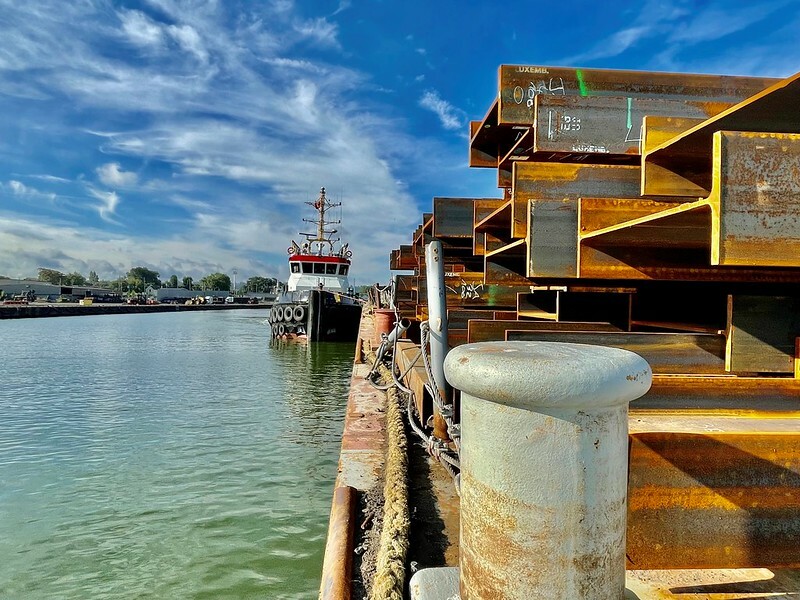Steel and steel-making materials surged at U.S. Great Lakes-Seaway ports in October driven by regional manufacturing and construction activity.
According to the latest figures from the St. Lawrence Seaway, 28.5 million metric tons of cargo have moved through the Seaway (from March 22 to October 31), up 1.9% from the same period in 2020.
General cargo (up 65%) led the way in October with steel imports expected to continue to hold strong through the balance of the year.
Iron ore volumes via the Seaway (up 20%) continue to be robust, driven in part by pellet exports from Minnesota ports. Canadian ships have been transporting the pellets from the Port of Duluth-Superior and Silver Bay to Quebec, where they are loaded on to larger ships for export to Europe. Dry bulk shipments through the Seaway are up 8% due to the cross-border trade of materials for building projects.
Meanwhile, liquid bulk shipments (down 5%) are slowly improving as petroleum shipments (including jet fuel and gasoline) increased to meet rising leisure air travel and more motorists hitting the road. Grain shipments (including U.S. and Canadian) via the Seaway, however, are down 21%.
“The valleys we’ve seen with some commodities like grain have been balanced by peaks in other cargoes to supply the steel and manufacturing sectors, which are trying to keep up with booming consumer demand,” Bruce Burrows, president and CEO of the Chamber of Marine Commerce, said in a statement announcing the numbers. “The Great Lakes-St. Lawrence Seaway shipping system is delivering for our customers without delay or interruption.”
The Port of Duluth-Superior closed October with total tonnage (26,024,364 short tons) tracking 2.5% ahead of the five-season average and 33% better than the 2020 pace, which was slowed by Covid-19. Iron ore remains a hot commodity, with more than 2 million short tons leaving the port in October. That float pushed Duluth-Superior’s season total to 16.4 million short tons, which exceeded the five-season average by 16%.
Beyond iron ore, inbound cement tonnage continued its brisk climb, with nearly 35,000 short tons arriving in October. For the season, Duluth-Superior has welcomed more than 241,000 short tons of cement, exceeding the five-season average by 67%.
Another positive for Duluth-Superior, but on a smaller scale, nearly 6,000 short tons of general cargo transited the port in October, bringing the season-to-date total within range of 2020’s five-season high in that category (41,256 short tons).
“The flexibility we offer shippers to switch between modes of transport to and from our multimodal general cargo terminal has been an advantage for them in navigating the global supply chain challenges of 2021,” said Deb DeLuca, executive director of the Duluth Seaway Port Authority. “So far, it’s truly been a season that emphasizes the importance of supply chain reliability and versatility, and we deliver on those in Duluth-Superior.”
Through October, tonnage has surpassed nine million tons for the Port of Toledo, an increase of over 25%. Domestic tonnage is up over 48% and trade with Canada has increased by 14%. Iron ore, coal, general cargo and dry bulk commodities are all tracking ahead of last year.
“We have nearly surpassed our 2020 tonnage total and we’re only in October,” said Joseph Cappel, VP of business development for the Toledo-Lucas County Port Authority.
While most of the increase is attributed to additional domestic iron ore shipments associated with the Cleveland Cliffs direct reduction plant, Toledo is also experiencing increases in coal, dry bulk and general cargo.
“Commodities like salt, aluminum, and other bulk material have been strong this year and we are always working on accelerating the supply chain for these cargos through our terminals,” Cappel said. “To that end, we have acquired and started using our new Liebherr 550 mobile harbor crane in combination with our two Liebherr 280 cranes for material handling at Midwest Terminals. The new Liebherr 550 crane has lift capacity of 154 metric tons and can be utilized for project cargo, breakbulk and bulk commodities. The buckets for the new crane are enormous and have already increased our efficiency and productivity.”
The Port of Monroe had several significant calls to the Port through October. The Harvest Spirit of McKeil Marine called on the port’s Riverfront dock to discharge a cargo of steel coils from Nanticoke, Ontario and was underway for her next port less than 24 hours after discharge operations began.
The barge New York/Double Skin 509A operated by Vane Brothers made two calls to the port with shipments of liquid asphalt to Michigan Paving & Materials. The Herbert C. Jackson of The Interlake Steamship Co. paid its third visit of the season to Monroe at the end of the month, loading cargo for delivery to the Lafarge Cement plant in Alpena, Mich.




